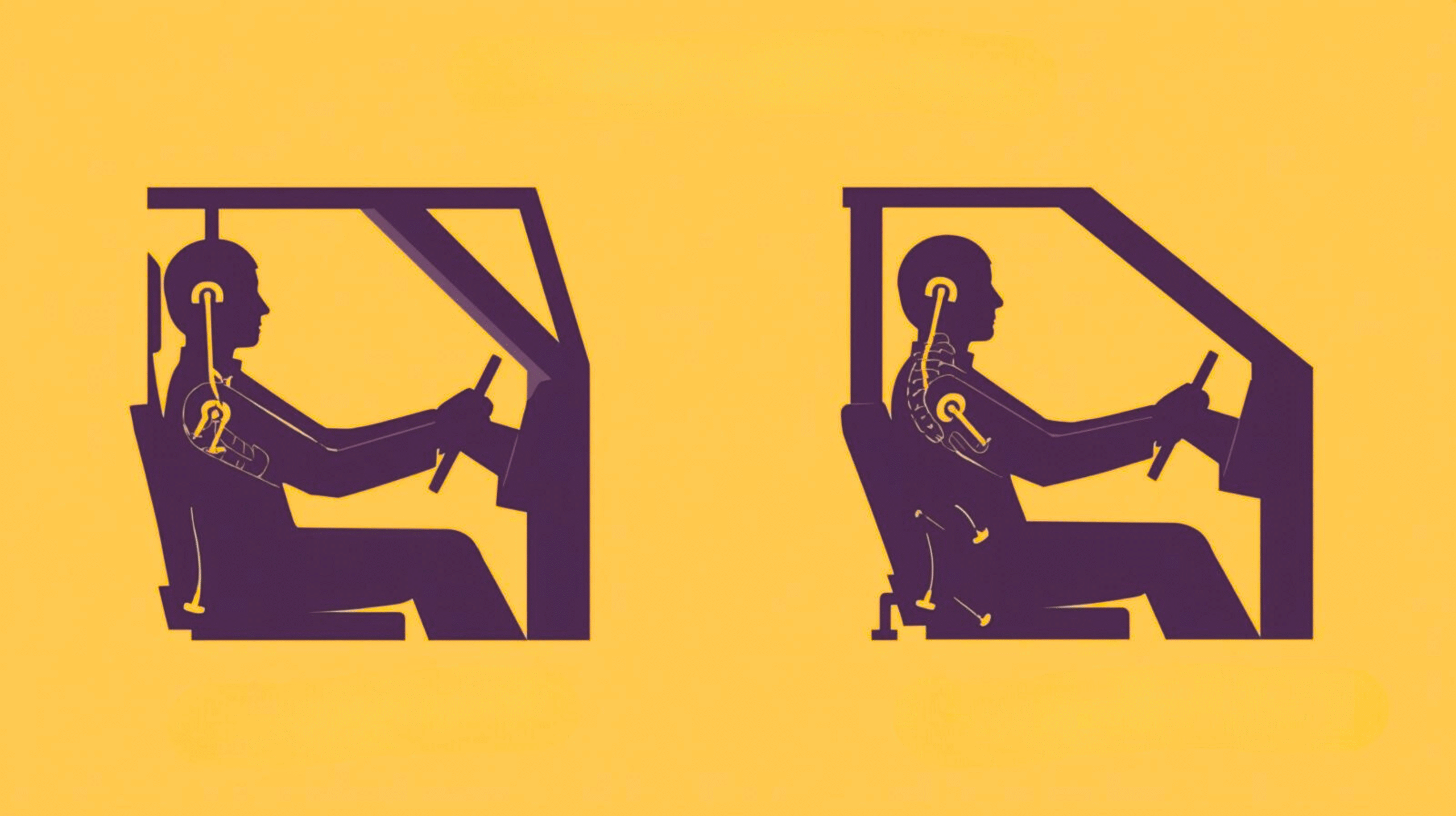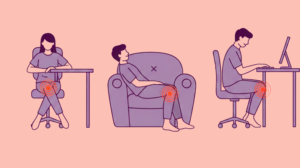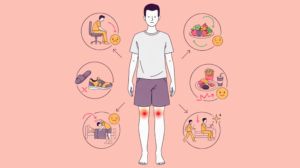Ever noticed how stiff or tight your back feels after a long drive? Or how your shoulders build up toward your ears and your neck feels tight after hours behind the wheel? You’re not alone. Millions of people spend hours driving each day commuting to work, dropping off their kids, or running errands without realizing that this routine can quietly take a toll on their posture. Driving might feel like a routine task, but over time, it can lead to lasting changes in the way your spine aligns, how your muscles work, and even how your body ages. However, there are simple, practical changes you can start today to undo the damage and protect your posture for years to come.
Let’s explore how driving affects your body and what you can do to feel better? Not just now, but for years to come.
The Hidden Impact of Driving on Your Posture
How Prolonged Driving Mimics Harmful Sedentary Habits?
Driving is often compared to sitting at a desk, but it’s actually worse in some ways. You’re not only seated for extended periods, but your body is often locked into a position that limits movement. You brace your arms on the wheel, press your feet on the pedals, and lean slightly forward. Over time, this rigid, static position mimics and even magnifies the harmful effects of a sedentary lifestyle [1].
What Happens to Your Spine During Long Commutes?
When you sit for too long, especially in a slouched or poorly supported position, the natural curve of your spine flattens. This puts uneven pressure on your spinal discs, especially in the lumbar (lower back) and cervical (neck) regions. Add the vibrations of the car and the stress of traffic, and your spine ends up absorbing a lot more shock than it should [2].
Stress on the Lumbar and Cervical Spine
Two key areas suffer the most:
- Lumbar spine: Prolonged driving can cause your pelvis to tilt backward, leading to rounding of the lower back and compression of lumbar discs.
- Cervical spine: Looking down or leaning forward while driving, especially to check mirrors or screens, causes strain in the neck. This forward head posture pulls the spine out of alignment, often leading to neck pain and headaches [3].
Common Postural Problems Caused by Driving
Rounded Shoulders and Forward Head Posture
This is one of the most common driving-related posture issues. You grip the steering wheel and slightly hunch forward. With time, the muscles in the chest tighten, and the muscles in the upper back weaken. This leads to rounded shoulders and the dreaded posture where your head juts forward, placing extra strain on your cervical spine.
Lumbar Rounding and Compressed Discs
Many car seats don’t offer proper lumbar support. When the lower back isn’t supported, the spine rounds into a “C” shape. This compresses the spinal discs and contributes to back pain, disc bulges, and nerve compression , particularly if you already sit for long hours at work [4].
Hip Tightness and Reduced Spinal Mobility
Sitting for a long period of time keeps your hips flexed, causing the front hip muscles to stiffen. This reduces hip movement and can lead to postural problems like an exaggerated lower back curve when standing. Over time, it may affect walking mechanics and increase spinal stiffness. [5].
Poor Thoracic Extension and Slouched Mid-Back
Most car seatbacks are reclined slightly, which reduces thoracic (mid-back) extension. Over time, this can lead to a hunched mid-spine, affecting breathing mechanics, limiting shoulder mobility, and making upright posture feel uncomfortable when you’re out of the car.
Circulation Problems and Nerve Compression
Prolonged sitting, especially without shifting weight reduces blood flow to the lower limbs. It can also compress the sciatic nerve, especially if your wallet or phone is in the back pocket, which causes radiating pain down the leg (sciatica-like symptoms). Over time, poor circulation contributes to varicose veins, numbness, and swelling.
How Aging Magnifies the Postural Effects of Driving
As we age, our bodies naturally undergo changes: slower healing, decreased flexibility, and reduced muscle strength. When poor driving posture becomes part of your routine, these changes can accelerate dramatically, leading to long-term complications.
- Disc Degeneration Becomes More Likely: Prolonged sitting and slouched posture while driving compress the intervertebral discs, which already lose hydration with age, making degeneration, bulging, or herniation more likely.
- Joint Stiffness and Limited Mobility: Long hours in a fixed seated position reduce joint lubrication and movement, leading to increased stiffness in the hips, spine, and knees, especially in older adults.
- Slower Recovery from Inflammation: Aging naturally slows down the body’s recovery process, so even minor postural strain from driving can trigger soreness that affects for days or becomes chronic.
- Loss of Muscle Strength in Core and Glutes: Sedentary driving habits weaken core and glute muscles that support upright posture and aging makes it harder to rebuild that strength once it’s lost.
- Kyphosis and Shrinking Posture: Poor driving posture sustains forward head position and rounded shoulders, accelerating age-related spine curvature like thoracic kyphosis and contributing to visible height loss.
- Greater Risk of Chronic Conditions: The combination of reduced mobility, muscle weakness, and spine compression boost the chance of age-related health problems like sciatica, arthritis, and spinal stenosis.
- Driving Habits Can Speed Up Biological Aging: The cumulative strain from poor driving posture has been connected to cellular aging markers such as telomere shortening and boost oxidative stress, potentially accelerating aging.
How to Fix Driving-Related Posture Issues?
Car Ergonomics 101
Adjusting Seat Height, Tilt, and Lumbar Support
Adjust your seat so your hips are level with or slightly above your knees. This reduces pressure on your lower back. Tilt your seat slightly backward to support your spines’ natural curves.
By using a lumbar cushion or adjusting the built-in lumbar support to support the natural inward curve of your lower back. If your car lacks support, a rolled towel or foam support can help [7].
Proper Distance from Pedals and Wheel
Your knees should be slightly bent, and your feet should reach the pedals without needing to stretch. Your hands should rest on the wheel comfortably at 9 and 3 o’clock positions, with a slight bend in the elbows.
Headrest and Mirror Alignment
The top of the headrest should be at eye level. Adjust your mirrors after sitting up tall .This way, if your posture slips, you’ll notice it because you won’t be able to see clearly without adjusting.
Posture Awareness
Neck Alignment and Shoulder Engagement
If you gently tuck your chin in and keep your ears aligned over your shoulders. If you engage your upper back slightly so the shoulders stay neutral, not rounded forward.
Keeping the Spine Neutral While Driving
Imagine a gentle ‘S’ curve from your head to your lower back. Support this with cushions if needed, and avoid leaning heavily on one side or slouching.
Take Movement Breaks
How Often You Should Stop During Long Drives
Every 45-60 minutes, you must try to stop and stretch. If you’re on a highway or long trip, a quick walk or a few stretches outside the car can make a big difference in your circulation and joint mobility[8].
Mini Stretches You Can Do in Your Car
You should try shoulder rolls, neck rotations, seated pelvic tilts, and gentle hamstring stretches (if safe) even at stoplights or in parked cars. These small moves keep your joints and muscles from stiffening up.
Pre- and Post-Drive Exercises
Stretches for Tight Hips and Hamstrings
- Kneeling hip flexor stretch
- Standing hamstring stretch
- Seated glute stretch
These target the key muscles that get tight during prolonged sitting.
Strengthening the Core and Glutes
A weak core leads to more strain on your lower back. Try these exercises regularly to strengthen your support system:
- Glute bridges
- Bird-dog
- Dead bug
- Side planks
A strong core and active glutes protect your spine both during and after driving.
Integrating Postural Care Into Daily Aging Wellness
Why Posture Correction Is Preventive Aging Care
Good posture isn’t just about looks, it’s about keeping your spine healthy, your joints moving, and your brain alert. Research shows that upright posture can reduce fatigue, improve mood, and even prevent cognitive decline by supporting blood flow to the brain [9].
Correcting your driving posture helps you feel younger, move better, and stay independent longer.
Daily Habits to Complement Better Driving Posture
- Use posture reminder apps or wearable sensors
- Practice daily stretching and mobility exercises
- Sleep with a pillow that supports your neck and spine
Tools and Props for Sustainable Improvements
- Lumbar cushions for the lower back
- Seat wedges to improve hip alignment
- Posture corrector braces (use temporarily)
- Anti-vibration seat pads to reduce spine impact
These tools can help maintain alignment and reduce discomfort on the road.
When to Seek Expert Help
Signs That Your Driving Posture Has Led to Chronic Issues
- Pain lasting more than a few weeks
- Numbness, tingling, or radiating pain in legs or arms
- Difficulty sitting or standing for long periods
- Stiffness that limits daily activities
These symptoms might indicate something deeper, like disc compression or nerve irritation, and shouldn’t be ignored.
How Physiotherapists Can Guide Posture Correction
A physiotherapist can analyze your posture, muscle imbalances, and driving setup. They’ll recommend stretches, strengthening plans, and ergonomic tools customized to your needs.
Mobility and Postural Screenings for Middle-Aged Adults
If you’re over 40 and drive regularly, an annual postural check-up is just as important as an eye check up. Early intervention helps prevent long-term degeneration and pain.
Frequently Asked Questions:
1. Why does driving cause back and neck pain?
Driving causes you to sit in a fixed, often slouched position for long periods. This strains your spine, tightens muscles, and compresses discs.
2. Can poor driving posture lead to chronic problems as I age?
Yes. Over time, it can contribute to disc degeneration, arthritis, nerve issues, and chronic pain.
3. What exercises help fix posture after driving?
Core strengthening, hip mobility work, hamstring stretches, and upper back activation exercises can help reverse the effects of poor driving posture.
4. Does poor driving posture affect other parts of the body?
Absolutely. It can lead to shoulder impingement, hip pain, headaches, and even poor digestion due to slouching.
5. Can improving driving posture reduce fatigue and pain?
Yes. A better-aligned spine allows your muscles to work efficiently, which reduces fatigue, improves circulation, and lowers pain levels.
References:
- Lis A. M., Black K. M., Korn H., Nordin M. (European Spine Journal, 2007) – Association between sitting and occupational low back pain (Eur Spine J 16(2): 283–298).
Link: https://doi.org/10.1007/s00586-006-0143-7 MSK Science and Practice+9ResearchGate+9The Open Dentistry Journal+9 - Callaghan J. P., McGill S. M. (Ergonomics, 2001) – Low back joint loading and kinematics during standing and unsupported sitting (Ergonomics 44(3): 280–294).
Link: https://doi.org/10.1080/00140130118276 DeepDyve+14Taylor & Francis Online+14Neurotree+14 - Szeto G. P. Y., Straker L. M., O’Sullivan P. B. (Manual Therapy, 2005) – A comparison of symptomatic and asymptomatic office workers performing monotonous keyboard work – 2: neck and shoulder kinematics (Man Ther 10(4): 281–291).
Link: https://doi.org/10.1016/j.math.2005.01.005 MSK Science and Practice+6ResearchGate+6IASP+6 - Adams M. A., Roughley P. J. (Spine, 2006) – What is intervertebral disc degeneration, and what causes it? (Spine 31(18): 2151–2161).
Link: https://doi.org/10.1097/01.brs.0000231761.73859.2c PubMed+8research-information.bris.ac.uk+8e-neurospine.org+8pmc.ncbi.nlm.nih.gov+1SCIRP+1 - Mork P. J., Westgaard R. H. (Spine health context, 2009) – Low back pain and prolonged static sitting in car drivers, cited in trunk kinematics studies linking long sitting exposures to low back pain.
Link: Discussion summarized in Nairn et al. and Mork & Westgaard studies via ResearchGate summary physio-pedia.com+2ResearchGate+2ScienceDirect+2 - Whole Body Vibration studies (Occupational and Environmental Medicine, etc.) – Reports linking prolonged vibration exposure in vehicle operators to lumbar spine stress and low back pain.
Link: https://pubmed.ncbi.nlm.nih.gov/ (cited via review)pmc.ncbi.nlm.nih.gov+6journals.sagepub.com+6blogs.cdc.gov+6 - Wilkes C. et al. (Journal of Behavior Therapy and Experimental Psychiatry, 2017) – Upright posture improves mood and reduces fatigue in people with depressive symptoms.
Link: https://pubmed.ncbi.nlm.nih.gov/27494342/medicalxpress.com+4psychologytoday.com+4facebook.com+4PubMed























